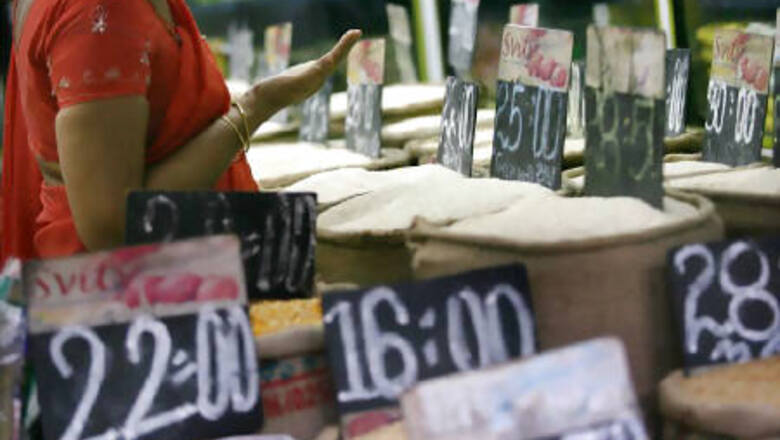
views
New Delhi Inflation moved up to 7.55 per cent in May because of spurt in prices of potato, pulses and wheat, although onion and fruits showed a declining trend.
Inflation, as measured by the Wholesale Price Index (WPI), was 7.23 per cent in April. In May last year, however, it was 9.56 per cent.
Overall food inflation rose to 10.74 per cent in May, from 10.49 per cent in April. Food articles have 14.3 per cent share in the WPI basket.
Potatoes turned costlier by 68.10 per cent during May on annual basis. For April, the rate of price rise was 53.44 per cent. Besides, pulses and wheat turned expensive by 16.61 per cent and 6.81 per cent respectively.
However, vegetables inflation was lower at 49.43 per cent in May. In April, the rate of price rise was 61 per cent.
Besides, eggs, meat and fish prices rose 17.89 per cent during the month, slightly higher than 17.54 per cent in April, the official data released today showed.
Inflation in milk was 11.90 per cent, while rice and cereals turned costlier by 5.07 per cent and 5.73 per cent respectively.
Onion prices declined (-)7.23 per cent in May. The rate of decline was (-)12.11 per cent in April.
Non-food manufactured inflation showed some easing and was 5.02 per cent in May. It was 5.12 per cent in April. The headline inflation number for March was revised upwards to 7.69 per cent, from the provisional estimate of 6.89 per cent.
Inflation in overall primary articles crossed the double digit mark to 10.88 per cent in May, from 9.71 per cent in April. Also, inflation in non-food primary articles, which include fibres and oilseeds, increased sharply by 8.47 per cent in May. In April, it was 1.61 per cent.
In the 'fuel and power' segment inflation rose by 11.53 per cent on an annual basis. The rate of price rise was 11.03 per cent in the previous month. As per the official data, oil seed prices shot up by 19.18 per cent in May. The rate of price rise was 16.66 per cent in April.
On year-on-year basis, among manufactured items, iron grew dearer by 14.93 per cent, while edible oil prices rose by 10.53 per cent. Inflation in tobacco products and basic metals was 7.80 per cent and 10.31 per cent respectively.
Experts said the inflationary pressure, driven by prices of food articles, will keep the pressure on the government to remove supply side bottlenecks. Overall inflation hovered at double digit for most of 2010 and 2011. The Reserve Bank hiked key policy rates 13 times, totalling 350 basis points, between March 2010 and October 2011 to tame inflation.
Since January, RBI has resorted to injecting liquidity into the financial system, by reducing Cash Reserve Ratio for banks. Besides, it has called for fiscal steps by the government to combat inflation.
However, in its annual monetary policy last month, RBI cut key lending rate by 50 basis points to lower borrowing costs amid falling industrial and economic growth.
RBI has projected inflation to be around 6.5 per cent by March 2013, with a caution that it will remain sticky and there is need to arrest the decline in economic growth.




















Comments
0 comment